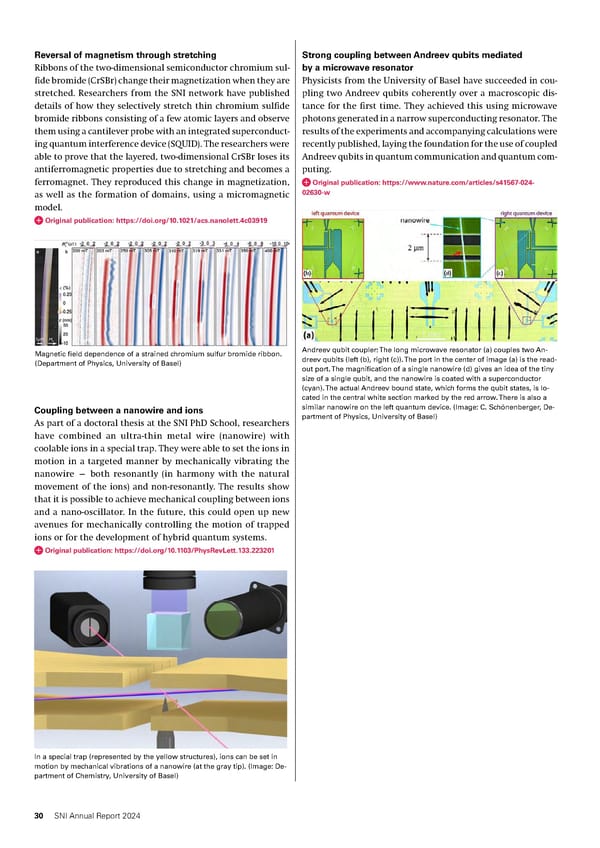Reversal of magnetism through stretching Strong coupling between Andreev qubits mediated Ribbons of the two-dimensional semiconductor chromium sul- by a microwave resonator fide bromide (CrSBr) change their magnetization when they are Physicists from the University of Basel have succeeded in cou- stretched. Researchers from the SNI network have published pling two Andreev qubits coherently over a macroscopic dis- details of how they selectively stretch thin chromium sulfide tance for the first time. They achieved this using microwave bromide ribbons consisting of a few atomic layers and observe photons generated in a narrow superconducting resonator. The them using a cantilever probe with an integrated superconduct- results of the experiments and accompanying calculations were ing quantum interference device (SQUID). The researchers were recently published, laying the foundation for the use of coupled able to prove that the layered, two-dimensional CrSBr loses its Andreev qubits in quantum communication and quantum com- antiferromagnetic properties due to stretching and becomes a puting. ferromagnet. They reproduced this change in magnetization, Original publication: https://www.nature.com/articles/s41567-024- as well as the formation of domains, using a micromagnetic 02630-w model. Original publication: https://doi.org/10.1021/acs.nanolett.4c03919 Magnetic field dependence of a strained chromium sulfur bromide ribbon. Andreev qubit coupler: The long microwave resonator (a) couples two An- (Department of Physics, University of Basel) dreev qubits (left (b), right (c)). The port in the center of image (a) is the read- out port. The magnification of a single nanowire (d) gives an idea of the tiny size of a single qubit, and the nanowire is coated with a superconductor (cyan). The actual Andreev bound state, which forms the qubit states, is lo- cated in the central white section marked by the red arrow. There is also a Coupling between a nanowire and ions similar nanowire on the left quantum device. (Image: C. Schönenberger, De- As part of a doctoral thesis at the SNI PhD School, researchers partment of Physics, University of Basel) have combined an ultra-thin metal wire (nanowire) with coolable ions in a special trap. They were able to set the ions in motion in a targeted manner by mechanically vibrating the nanowire — both resonantly (in harmony with the natural movement of the ions) and non-resonantly. The results show that it is possible to achieve mechanical coupling between ions and a nano-oscillator. In the future, this could open up new avenues for mechanically controlling the motion of trapped ions or for the development of hybrid quantum systems. Original publication: https://doi.org/10.1103/PhysRevLett.133.223201 In a special trap (represented by the yellow structures), ions can be set in motion by mechanical vibrations of a nanowire (at the gray tip). (Image: De- partment of Chemistry, University of Basel) 30 SNI Annual Report 2024
 Annual Report 2024 - Swiss Nanoscience Institute Page 29 Page 31
Annual Report 2024 - Swiss Nanoscience Institute Page 29 Page 31